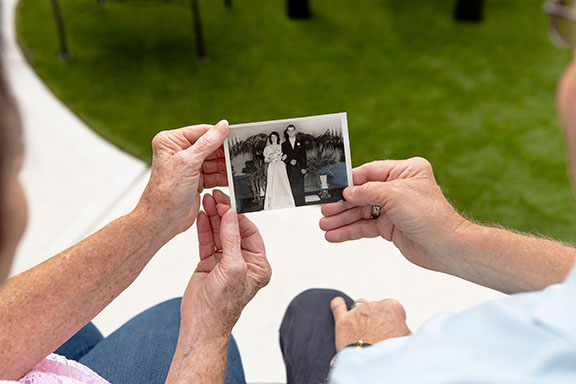Life for those living with diagnoses of neurocognitive disorders is a daily struggle. Confusion reigns over so much of their day along with a variety of other additional emotions such as fear, frustration, anxiety, depression, anger, etc. Some emotions are caused by the disease process with which they are living, others are caused by external factors such as the environment, time of day, a structured vs. an unstructured day, team member approach, and other factors. Because of these factors, emotionality among our residents is expected, and it is served with empathy and compassion.
As we have seen over the past 20+ years, philosophies, approaches, and care practices have changed due to continuing research and work by memory care thought leaders. Primrose Retirement Communities embrace the person-centered care approach to resident quality of life and are committed to applying it in a meaningful way to honor the preferences of our residents.
Person-Centered Care
We hear the term “Person Centered Care” on almost a daily basis within our field of work. But what does it really mean, and are we really offering it to our residents? While many definitions of Person-Centered Care exist, in 1997, Tom Kitwood was the first to define it in a meaningful way. He started off with the concept of “personhood” in attempt to address very poor care practices that were in place for those living with dementia at the time. He said that personhood is “‘a standing or status that is bestowed upon one human being, by others, it implies recognition, respect and trust. Through this recognition, respect and trust, the personhood of an individual will be enhanced as well as their wellbeing. If the opposite occurs, then personhood will diminish, leading to ‘illbeing’.”

He went on to define how we support resident wellbeing through “Positive Person Work”, including honoring our residents’ core psychological needs. Those needs being: Identity, Occupation, Comfort, Inclusion, Attachment, and Love. Primrose Retirement Communities embraces this approach to resident quality of life and is committed to applying it in a meaningful way on behalf of the residents.
Some examples of Person-Centered Care are:
- Allowing residents to sleep as early or as late as the wish, reflecting their previous sleeping habits.
- Offering a small continental breakfast versus a hearty farm breakfast, depending on resident preference.
- Scheduling showers/baths per resident pre-move-in habits rather than having schedules for the convenience of the care team.
- Seeing behavioral expressions as a form of communication on the part of a person living with dementia and creating individualized proactive and responsive interventions accordingly.
- Ensuring that all residents’ interests are considered when developing Life Enrichment opportunities and all residents are encouraged to participate in community offerings, or 1:1 experiences per their preference.
- Offering opportunities for residents to engage in programs that bring purpose and meaning, not just busyness.
- Ensuring that the Silver Lace neighborhood and resident apartments reflect a feeling of home, rather than that of an institutional or medical setting.
- Allowing residents to make clothing choices.,
- Allowing pre-move in habits guide the order in which morning traditions are offered to each resident.
Approach and Interactions
In offering a Person-Centered approach, we must remember that residents will have their own unique ways in which they prefer to be approached. This is especially true in the morning when residents are still awakening and trying to make sense of their surroundings. Using a thoughtful approach with each resident, and knowing their history, likes, and dislikes will help the morning get off to a better start.
Some common approaches to assist a resident in the morning would be:
- Always identify yourself and your role
- Use resident’s preferred name
- Make eye contact
- Sit down with resident, if possible
- Give resident your full attention
- Speak slowly
- Be patient
- Ask one question or give one direction at a time
- Ask how you can help
- Reassure with words or touch
- If frustration occurs, stop

The embodiment of person-centered care with Silver Lace Memory Care at Primrose is exemplified through various practices. From respecting residents’ sleeping habits to tailoring meals, showers, and engagements based on individual preferences, every aspect of care is meticulously crafted to honor the core psychological needs of identity, occupation, comfort, inclusion, attachment, and love. This commitment extends to creating a home-like environment, allowing residents to make personal choices, and offering purposeful activities that transcend mere busyness.
Recognizing that approach and interactions play a pivotal role, the staff at Primrose emphasizes a thoughtful and individualized approach during morning interactions. Personalizing interactions by using preferred names, making eye contact, and fostering patience contributes to a positive start to the day for residents navigating the challenges of awakening and sense-making.
The person-centered care philosophy at Primrose Retirement Communities not only acknowledges the complexities of neurocognitive disorders but actively seeks to enhance the quality of life for residents. Through empathetic and compassionate practices, Primrose exemplifies a commitment to evolving care methodologies that prioritize the uniqueness and dignity of each individual in their care.
Silver Lace Vision Statement
“Primrose Retirement Communities Silver Lace neighborhoods provide home environments embracing Person Centered, holistic aspects that provide our residents with fully faceted life enriching opportunities and current dementia-supportive practices. Resident family members are viewed as a part of our mission, deserving of their own compassion, resources, and support. Innovation is embraced, promoting the continued enhancement of our memory care services within assisted living venues. Aspects of home are maximized while institutional aspects are minimized. Ours is a mission-driven approach that is underpinned with compassion, empathy, and advocacy, fully embracing the Primrose Core Values.”
Silver Lace Memory Care by Primrose
To continue to honor Primrose tradition and values, we have selected the name “Silver Lace” to recognize our memory care offerings. Silver Lace is a variety of Primrose that is characterized by deep purple petals, each surrounded by a “silver” border. We feel that this flower translates nicely to our memory care services by honoring the purple awareness color of Alzheimer’s disease. Additionally, although we recognize that Alzheimer’s disease, and other forms of dementia, are incredibly challenging journeys to navigate, we feel that we can provide a “silver lining” to those experiences by providing home environments rich with Person Centered quality of life experiences that will assist our residents in finding their continued full potential within Primrose Memory Care communities.
Silver Lace Memory Care program is only available at select Primrose Retirement locations. Click here to see if a location near you offers the program: Silver Lace Memory Care by Primrose Retirement | Primrose
